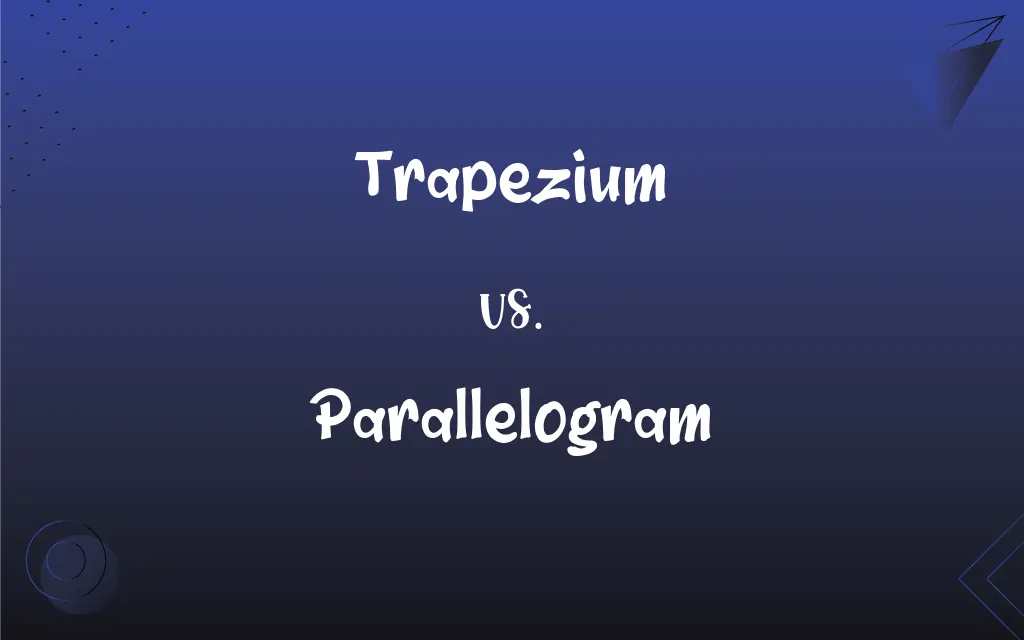Trapezium vs. Parallelogram: What's the Difference?
Edited by Aimie Carlson || By Janet White || Published on February 19, 2024
A trapezium is a quadrilateral with at least one pair of parallel sides, while a parallelogram is a quadrilateral with two pairs of parallel sides.

Key Differences
A trapezium, in geometry, is defined as a four-sided figure with at least one pair of parallel sides. A parallelogram, by contrast, has two pairs of parallel sides, making opposite sides equal in length and parallel.
The angles in a trapezium are not necessarily equal or supplementary. In a parallelogram, opposite angles are equal, and adjacent angles are supplementary.
The sides of a trapezium can be of different lengths and do not necessarily form right angles. In a parallelogram, the opposite sides are not only parallel but also equal in length.
Area calculation for a trapezium involves the average of the parallel sides multiplied by the height. For a parallelogram, the area is calculated by multiplying the base by the height.
A trapezium does not have lines of symmetry in general, whereas a parallelogram usually has at least one line of symmetry.
ADVERTISEMENT
Comparison Chart
Parallel Sides
At least one pair
Two pairs
Angle Properties
Not necessarily equal or supplementary
Opposite angles equal, adjacent supplementary
Side Lengths
Unequal, not specifically parallel
Opposite sides equal and parallel
Area Calculation
Average of parallel sides x height
Base x height
Symmetry
Usually none
At least one line of symmetry
ADVERTISEMENT
Trapezium and Parallelogram Definitions
Trapezium
A polygon with at least two sides that are not parallel.
The trapezium's unique shape makes it interesting in designs.
Parallelogram
A polygon with opposite angles equal.
In art class, we used parallelograms to create tessellations.
Trapezium
A geometric shape varying in side lengths and angles.
We used a trapezium to demonstrate different angle properties.
Parallelogram
Has adjacent angles that are supplementary.
Parallelograms demonstrate properties of angle relationships.
Trapezium
Characterized by having only one pair of parallel sides.
The trapezium is distinct from a parallelogram in its parallel sides.
Parallelogram
A quadrilateral with two pairs of parallel sides.
A rectangle is a type of parallelogram with right angles.
Trapezium
A quadrilateral with one pair of parallel sides.
In class, we learned how to calculate the area of a trapezium.
Parallelogram
Typically has at least one line of symmetry.
The parallelogram's symmetry makes it balanced in design.
Trapezium
A four-sided figure, not necessarily symmetrical.
The garden's layout is shaped like a trapezium.
Parallelogram
A shape where opposite sides are equal and parallel.
The area of a parallelogram is simple to calculate.
Trapezium
A quadrilateral having no parallel sides.
Parallelogram
A four-sided plane figure with opposite sides parallel.
Trapezium
Chiefly British A trapezoid.
Parallelogram
(geometry) A convex quadrilateral in which each pair of opposite edges are parallel and of equal length.
Trapezium
(Anatomy)A bone in the wrist at the base of the thumb.
Parallelogram
Either of two rectangular areas (respectively the large parallelogram and the small parallelogram) abutting the goal line in front of the goal. (Since 1986 officially named the large rectangle and small rectangle, though the older names are still occasionally used.)
Trapezium
A quadrilateral with two sides parallel.
Parallelogram
A right-lined quadrilateral figure, whose opposite sides are parallel, and consequently equal; - sometimes restricted in popular usage to a rectangle, or quadrilateral figure which is longer than it is broad, and with right angles.
Trapezium
(restrictively) A quadrilateral with two sides parallel and two sides non-parallel.
Parallelogram
A quadrilateral whose opposite sides are both parallel and equal in length
Trapezium
A four-sided polygon with no parallel sides and no sides equal; a simple convex irregular quadrilateral.
Trapezium
(anatomy) The trapezium bone of the wrist.
Trapezium
A region on the ventral side of the brain, either just back of the pons Varolii, or, as in man, covered by the posterior extension of its transverse fibers.
Trapezium
A plane figure bounded by four right lines, of which no two are parallel.
Trapezium
A bone of the carpus at the base of the first metacarpal, or thumb.
Trapezium
A quadrilateral with no parallel sides
Trapezium
A multiple star in the constellation of Orion
Trapezium
The wrist bone on the thumb side of the hand that articulates with the 1st and 2nd metacarpals
FAQs
Are all sides of a trapezium equal?
Not necessarily. A trapezium can have sides of different lengths.
Does a trapezium have right angles?
It can, but not always. It depends on the specific shape of the trapezium.
How many pairs of parallel sides does a trapezium have?
A trapezium has one pair of parallel sides.
How do you calculate the area of a trapezium?
The area is calculated as 0.5 * (sum of parallel sides) * height.
What is a parallelogram?
A parallelogram is a quadrilateral with two pairs of parallel sides.
What is an isosceles trapezium?
It's a trapezium with equal non-parallel sides and angles.
How do you calculate the area of a parallelogram?
The area is calculated as base times height.
Can a trapezium be symmetrical?
Yes, an isosceles trapezium is symmetrical.
Can a parallelogram have right angles?
Yes, a rectangle is a special type of parallelogram with right angles.
What is a trapezium?
A trapezium is a quadrilateral with at least one pair of non-parallel sides.
Does a trapezium have equal angles?
Not necessarily. Angles in a trapezium can vary.
Are the diagonals of a trapezium equal?
Not in general. They are equal in an isosceles trapezium.
Is a square a type of parallelogram?
Yes, a square is a parallelogram with all sides and angles equal.
Is a trapezium always convex?
Yes, by definition, a trapezium is a convex polygon.
Are opposite sides of a parallelogram equal?
Yes, opposite sides of a parallelogram are always equal.
Can a parallelogram be symmetrical?
Yes, rectangles and rhombi are examples of symmetrical parallelograms.
Are the diagonals of a parallelogram equal?
Not always, but they bisect each other.
What is the difference between a parallelogram and a rectangle?
All angles of a rectangle are right angles, which is not a requirement for a parallelogram.
Do the angles in a parallelogram add up to 360 degrees?
Yes, like any quadrilateral.
How are the opposite angles of a parallelogram?
Opposite angles are equal in a parallelogram.
About Author
Written by
Janet WhiteJanet White has been an esteemed writer and blogger for Difference Wiki. Holding a Master's degree in Science and Medical Journalism from the prestigious Boston University, she has consistently demonstrated her expertise and passion for her field. When she's not immersed in her work, Janet relishes her time exercising, delving into a good book, and cherishing moments with friends and family.
Edited by
Aimie CarlsonAimie Carlson, holding a master's degree in English literature, is a fervent English language enthusiast. She lends her writing talents to Difference Wiki, a prominent website that specializes in comparisons, offering readers insightful analyses that both captivate and inform.
































































